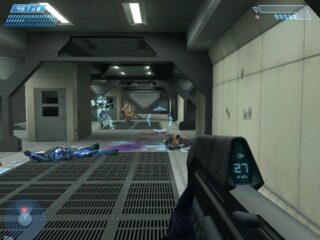The first-person shooter emerged as one of PC gaming's most defining and influential genres, fundamentally changing how players experienced action games by putting them directly behind the gun. While earlier experiments with first-person perspective existed, the genre truly began with id Software's Wolfenstein 3D in 1992, which used a clever raycasting engine to create smooth, fast-paced 3D corridors on 386 machines. Players took the role of B.J. Blazkowicz, escaping from a Nazi castle while mowing down guards with increasing firepower. The formula was perfected in Spear of Destiny, the standalone prequel that refined the gameplay mechanics and introduced more varied environments.
But it was Doom in 1993 that elevated the FPS from novelty to phenomenon. id Software's masterpiece didn't just improve the graphics and speed - it created an atmosphere of dread and intensity that was unprecedented. The game's engine allowed for more complex level geometry, varying light levels, and multiple floor heights, while the shotgun-wielding space marine became gaming's first true action hero. The addition of networked multiplayer through deathmatch modes created an entirely new social gaming experience that would define PC gaming culture.
The genre quickly diversified beyond id's sci-fi and military themes. Raven Software's Heretic transported the DOOM engine into a dark fantasy setting, introducing inventory items, flying mechanics, and magical weapons that showed how the FPS template could adapt to different universes. Doom II expanded on the original's formula with larger, more complex levels and the infamous super shotgun, while maintaining the relentless pace that made the series legendary.
Duke Nukem 3D revolutionized the genre again in 1996 with 3D Realms' Build engine, which allowed for truly interactive environments, destructible objects, and multiple route gameplay. Duke's wisecracking personality and the game's adult humor created a more character-driven experience, while technical innovations like room-over-room architecture and realistic locations made levels feel like actual places rather than abstract mazes.
id Software reclaimed the crown with Quake in 1996, introducing full 3D polygonal graphics and establishing the template for modern FPS design. The game's gothic horror atmosphere, combined with revolutionary online multiplayer through QuakeWorld, created the foundation for competitive FPS gaming. Quake II, despite being less horror-focused, refined the formula with improved graphics, more sophisticated AI, and mission-based gameplay that influenced countless future shooters.
The late 1990s saw remarkable genre experimentation. Monolith's Blood combined the Build engine with genuinely disturbing horror elements and creative weapons like the flare gun and voodoo doll, creating one of the most atmospheric FPS experiences ever made. Meanwhile, the same company later created No One Lives Forever, which proved that FPS games could successfully incorporate stealth mechanics, spy gadgets, and sophisticated storytelling, paving the way for more narrative-driven shooters.
From the simple corridor shooting of Wolfenstein 3D to the complex, story-driven experiences that followed, the FPS genre evolved rapidly through the 1990s, establishing gameplay mechanics, technical innovations, and design philosophies that continue to influence game development today.














